
Memento Mori: 1 2 3 4 5 6 Next>>
Memento Mori in the Golden Age of Piracy, Page 3
Grave Art
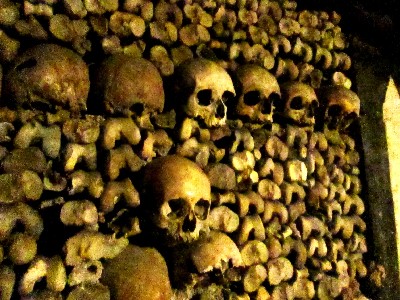
Photo: Mission - Artfully Arranged Relocated Bones in the Paris Catacombs
When thinking of grave markers, many people think of upright tombstones seen in graveyards. However, these types of tomb stones did not appear until the 17th century. Before that time, those with money might have elaborate grave makers, usually made parallel to the ground on the church floor.1
In the 14th century, grave art began to appear with realistic reminders of death upon it, the most shocking form of which was the transi or corpse tomb, which featured a decaying corpse representing the person buried there. Such sculptures were expensive and were usually reserved for people with money and/or power.
People without such means were usually buried wrapped in a shroud in ditches in the churchyard with unmarked graves. When these church yards became filled, the bones were transferred to ossuaries [chests, buildings or wells where the bones were stacked and stored] or charnel houses [buildings where bones were stored].2 These bones were sometimes arranged in artful ways as seen above.
By the 17th and 18th centuries, it became more possible and fashionable for the common man to purchase a grave marker. Skulls and other memento mori symbols were found on many such upright grave stones in Europe and on the American continent, which served as reminders to the living that life was fleeting. Just as there were many stonemasons cutting the grave stones, there were many different styles of rendering these memento mori designs as we will see.
1,2 Robert Darnton, "This history of mentalites", Structure, Consciousness and History, p. 122
Grave Art: Transi or Corpse Tombs
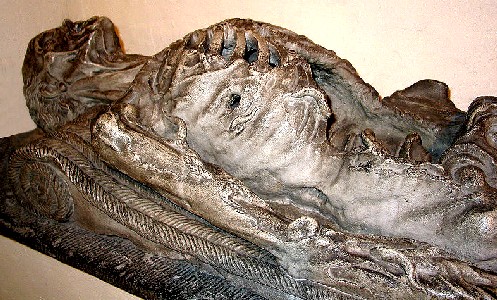
Transi Tomb Corpse L'homme a Moulons, Boussu, Belgium Jean-Pol Grandmont (16thc)
Perhaps the most vivid of all macabre art were found on Transi or Corpse Tombs, which began to appear in the 14th century, continuing to be used well into the 16th century. You will recall that a transi is a skeletal corpse with rotting and sometimes even parasite-infested skin. The Transi Tombs were sculpted to be parallel to the ground and contained two layers. On the top layer was a representation of the person as they were in life or immediately after death. On the bottom was "a rotting cadaver... often shrouded and sometimes complete with worms and other flesh-eating wildlife."1 Sometimes only the cadaver was shown.
As seen in the images here, Transi Tombs were elaborately carved and thus expensive. They "were made only for high-ranking nobles, usually royalty or bishops or abbots, because one had to be rich to
Photo: Lampman - Double Decker Transi Tomb of John FitzAlan, 14th Earl of Arundel (1435)
afford to have one made, and powerful enough to be allotted space for one in a church. Some tombs for royalty were double tombs, for both a king and queen."2 Paul Binski explains that the initial Transi
Tombs were "almost exclusively clerical, and only later lay [non-clerical]. They represent the kind of phenomenon whose initial reasons for existence may have differed from those of their later spread and validation, and in this sense there cannot have been a single 'cause' of the transi tomb."3
The meaning of a Transi or Corpse Tomb is clearly a form of memento mori - the pristine upper level statue showed the wealthy individual as they were in life while the barren, shrouded, rotting corpse revealed the futility of their wealth after death. Binski notes that these tombs "embodied a specifically Gothic representational feeling for the threatening and grotesque."4
He
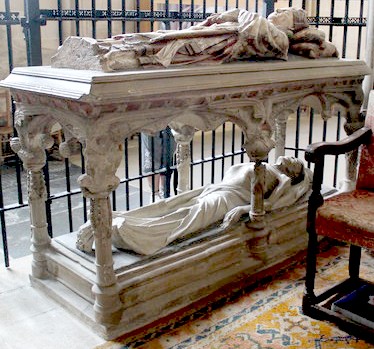
Photo: J. Hannan-Briggs
Transi Tomb of Bishop Bekynton, Wells Cathedral (1451)
goes on to rather poetically suggest that Transi Tombs "performed a kind of unmasking of that which had hitherto been concealed. Viewed in contest and in time, the transi tomb was a sophisticated anti-tomb, disclosing and glossing that which had been closed and denied for over two centuries. The transi tomb now revealed the skeleton in the cupboard of medieval funerary art, namely its denial of the facts of decomposition."5
It is notable that Transi or Corpse Tombs were primarily found in northern Europe and were limited to the 14th - 16th centuries. Binski found that of the "270 corpse tombs which survive from northern Europe in this period, under half a dozen date to the fourteenth century, seventy-five or so to the fifteenth, and over one hundred to the sixteenth century."6 He explains that they do not appear in Spain, Mediterranean France and Italy, making them culturally specific.7
Because Transi Tombs did not appear until the late 14th century, Binski suggests that these late-medieval sculptures were inspired by the "plague-motivated culture of the macabre."8 Having seen the horrors of the plague and the unrelenting death may have resulted in acceptance of such a grisly funerary monument. Binski also suggests an interesting parallel between the double-decker structure of the Tombs and the story of the Three Living and the Three Dead encountering one another.9
1,2 "Cadaver tomb", Wikipedia, gathered 9/20/14; 3 Paul Binski, Medieval Death: Ritual and Representation, p. 140; 4 Binski, p. 142; 5 Binski, p. 149; 6 Binski, p. 142; 7,8 Binski, p. 140; 9 Binski, p. 139
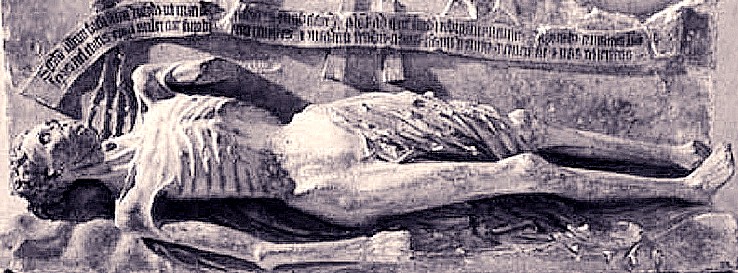 Transi Tomb of Jean de la Grange, Musée du Petit Palais, Avignon (1403) |
Grave Art: Memento Mori Themes
Photo: Roger Griffeth
Skull on a Sepulchre, Durisdeer Church,
Dumfries and Galloway, Scotland
Before the late 17th century, common folk were buried in unmarked mass graves in the churchyard. Writing in 1631 before widespread individual grave sites existed for regular people, John Weever explained the attitude about burial.
SEPULCHRES [monuments] should be made according to the quality and degree of the person deceased, that by the tomb every one might be discerned of what rank he was, living: for monuments answerable to men's worth, estates and places have always been allowed, and stately sepulchres for base fellows have always lain open to bitter jests; therefore it was the use of reverend antiquity, to interr persons of rustic or plebeian sort, in Christian burial, without any further Rememberance of them, either by tomb, grave-stone, or epitaph. Persons of the meaner sort of gentry were interred with a flat grave-stone, comprehending the name of the defunct, the year and day of his decease, with other particulars which were engraven on the said stone, or upon some plate.1
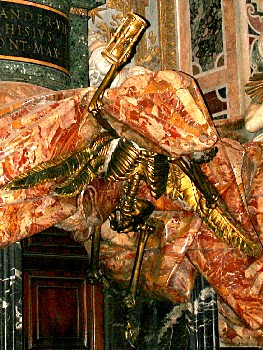
Photo: Jean-Pol Grandmont
Detail of Death Holding Hourglass from Pope
Alexander VII's Monument by Gian Lorenzo
Bernini (1678)
As already mentioned, memento mori emblems appeared on graves of those with sufficient power and/or wealth to allow them to have individual monuments erected in churches. An example of such monuments were those created by Gian Lorenzo Bernini, a popular Roman sculptor of the 16th and 17th Centuries. He created a Memento Mori monument for Pope Urbanus VIII and Pope Alexander VII at St. Peters. The elements contained in these sculptures ended up informing and influencing the monuments commissioned by others in the 17th and 18th centuries.2
In the mid- and late-17th century, the general populace began to erect gravestones for their dead. The societal change in focus from the collective to the individual noted by Paul Binski in the first page of this article, helps explains this movement towards individual head stones for the common man.3 Improved economics in the general society also played a role as families accumulated more wealth and were able to commission graves.4
Memento mori symbolism figured heavily in the artwork on graves, particularly in the late 17th and 18th century tomb stones. On the American continent, the death's head skull began to appear on simple head stones in 1680 and continued to be used until about 1790.5 Burial sites
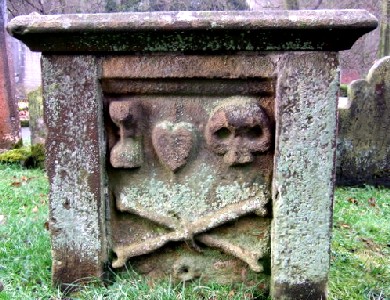
Photo: Ceridwen
Memento Mori Symbols on the End of a Tomb - Includes the Hourglass, a
Human Heart (perhaps representing the brevity of life), a Death's Head,
and Loose Crossed Bones - Near Matlock, England
featuring memento mori symbols can be found scattered along the eastern seaboard of the North American continent, "from Nova Scotia to Georgia wherever there were settlements, with the largest and oldest yards in the oldest cities."6
There are many European tomb stones that feature memento mori symbols from this time including tomb stones in Dijon and Dutch churches.7 As we have seen, memento mori symbology had been developing throughout the later middle ages and into the 17th century, particularly through the Vanitas art movement. It is likely grave marker art borrowed from these forms. The dominance of the Puritan church in New England during this time, with its focus on personal Biblical interpretation, likely influenced the memento mori motif in memorial monuments as well.
"The death's-head motif can be described as an 'earthy and neutral symbol, serving as a graphic reminder of death and resurrection.' When looking at the epitaphs on the gravestones in conjunction with the symbology of the death's-head, there is a focus on the mortality of man."8
Scott P. Richert notes, "The deceased usually requested that the [memento mori] sculpture be placed on his tomb as a warning to remaining family members (who would frequently visit the tomb) to attend to the good of their souls."9
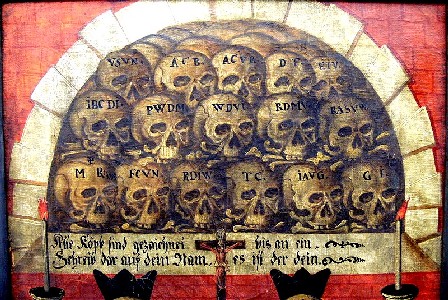
Photo: Wolfgang Sauber
Memento Mori Painting from Kitzbühl, Tyrol, Austria, The Inscription Reads, "All
skulls are signed but one; write your name on it, it is yours." (1694)
Symbols on gravestones often featured skulls, particularly with wings, full skeletons, hour glasses, bones, scythes, coffins10, "heavenly crowns, urns or the picks and shovels of the grave digger."11 The more morbid elements of memento mori grave art declined over time, practically disappearing from grave stones by the end of the 18th century.
The skull gradually gave way to less grim visages such as winged cherub faces and weeping willows.12 Jessie Lie Farber explains, "An analysis of the motifs on the stones in the [Harriette Merrifield] Forbes collection [of 1,370 photographs of more than 1,260 different head stones found along the Eastern seaboard] shows that in the period from 1675 to 1800, the prevalence of the skull/skeleton motif diminished from being almost exclusive to being present on about one in every thirty stones."13
One of the things I find fascinating about the memento mori grave art is the variety of representations it takes, particularly in the figuring of the skull. There is no "standard" skull carving - some were shockingly realistic while others are almost laughably cartoonish. This makes sense given the variety of artists who would have carved these stones as well as the various locales where the stones were carved.
We'll start with a couple of funerary monuments on the graves of those inside churches - places reserved for the wealthy or socially important. You can see a nice progression in styles from transi (skeleton with rotting skin) to clean skeleton to clean, separated memento mori-style skull and loose, crossed bones. This parallels the development of memento mori art over the time period.
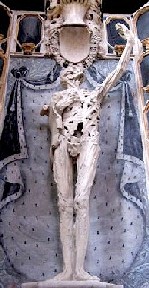 Transi, Prince of Orange: René of Châlon (1544) |
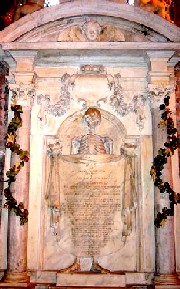 Diana Warburton's Tomb, St. John's Church, Chester (1693) |
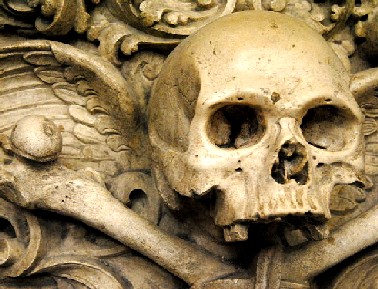 Winged Skull, From Sepulcro del Cardenal Salazar, Mosque of Córdoba, Capilla de Santa Teresa, Spain (1706) |
Of equal interest are the common gravestones from the 17th and 18th century. We begin with an assortment of skulls found on period and near-period graves.
|
Photo: Ydigresse Skull on Chest Tomb, Mappowder, UK (1703) |
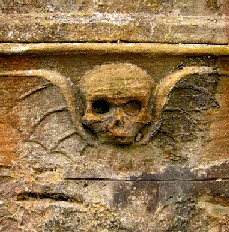 Photo: Martyn Gorman Bat-Winged Skull, Pencaitland, Scotland (17th/18th c.) |
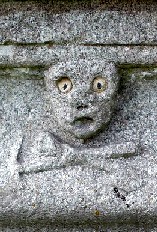 Photo: Nigel Nykura Staring Death in the Face, Whitcombe, England (1680) |
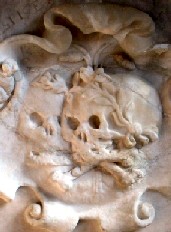 Photo: Ian Petticrew Edmund West's Tomb, Marsworth, England (1681) |
The next group of stone carvings includes several different types of markers. The first image is the grave stone for surgeon James Borthwick found at Greyfrier's Kirkyard (Church Yard) in Scotland. It features an animated skeleton holding what may be an hourglass. On either side appear to be rods of Asclepius, the symbol of surgeons, with surgical tools carved below. Beneath the skeleton on the grave stone is a death's head over crossed bones, flanked on either side by grave digger tools. The second image is of a pair of headstones found in the Maxton Churchyard in Scotland. Each grave stone features a skull with seperate crossed bones along with an hour glass tipped on its side - meaning time has run out. The second grave stone in the image features a winged cherub head, indicating the fleetingness of life. The last image is John Livingstone's Mausoleum stone in Greenhill, near Edinburgh, Scotland. It features a skull over crossed bones, on top of which are wings, indicating the fleetingness of life. Livingstone was an apothecary who died of the plague in 1645.
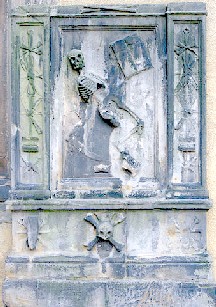 Photo: Kim Traynor Greyfrier's Kirkyard Stone (1676) |
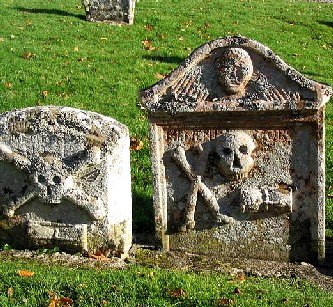 Photo: Walter Baxter Headstones in Maxton Churchyard, Scotland (17th/18th c.) |
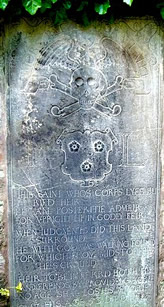 Photo: Kim Traynor Photo: Kim Traynor Livingstone Mausoleum (1645) |
These final images show even more variety in the types of skulls found on grave stones. It once again shows the great variety in skull representations from this era.
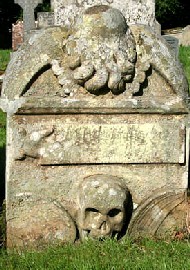 Photo: Walter Baxter Winged Skull and Winged Cherub, Bowden Churchyard, Scotland (18th) |
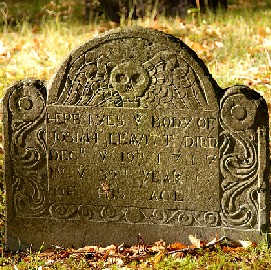 Photo: Dee E. Warencyia Winged Skull on Josiah Leavitt's Headstone, Hingham Center Cemetery, Plymouth, MA, US (1717) |
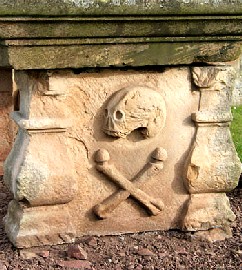 Photo: Walter Baxter Skull & Crossed ones on Table Stone Monument, Innerwick Church, Scotland (18th c.) |
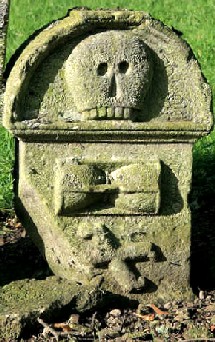 Photo: Walter Baxter Death's Head, Hourglass and Crossed Bones, Longnewton, Scotland (1706) |
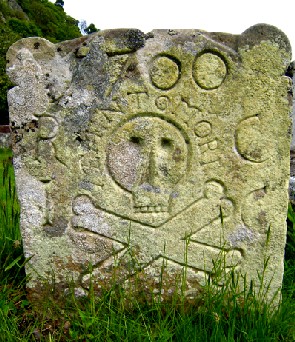 Photo: Martyn Gorman Memento Mori with Skull and Crossed Bones, Logie Old Kirk (Church), Scotland (1700) |
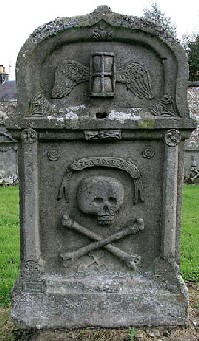 Photo: Walter Baxter Skull, Bones & Winged Hourglass, St. Andrew's, Scotland (17/18th c.) |
1 John Weaver, cited in William Tooke's Antient Funeral Monuments of Great-Britain, Ireland and the Islands adjacent, p. xi; 2 Roberto Piperno, "Memento Mori", romeartlover.com, gathered 9/20/14; 3 Paul Binski, Medieval Death: Ritual and Representation, p. 131; 4 "Gravestones and Memorials in Scotland", www.thereformation.info, gathered 10/9/14; 5 Megan L, "Skulls, Cherubs, and Willows, Oh My! – Interpreting 17th, 18th, & 19th Century Gravestones", nmscarcheologylab.wordpress.com, gathered 10/9/14; 6 Jessie Lie Farber, "Early American Gravestones", www.davidrumsey.com, gathered 10/9/14; 7 Philippe Aries, The Hour of Our Death, p. 114; 8 Megan L, gathered 10/9/14; 9 Scott P. Richert, Memento Mori, Catholocism.About.com, gathered 9/20/14; 10 Farber, gathered 10/9/14; 11 "Headstone", Wikipedia.com, gathered 10/9/14; 12 Megan L, gathered 10/9/14; 13 Farber, gathered 10/9/14;

